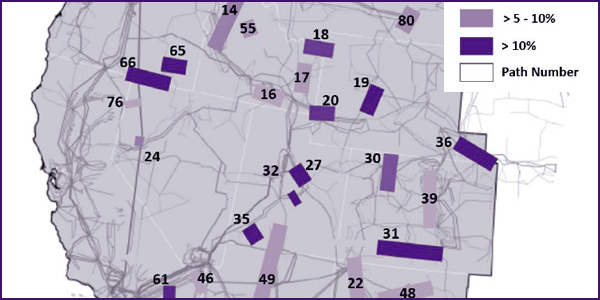Industry commenters last week accused the Department of Energy of overlooking crucial recent energy trends in its latest study of transmission congestion, in addition to relying on unexamined assumptions.
DOE released its report in September in accordance with the Energy Policy Act of 2005 (EPAct), which directs the department to conduct regular assessments of national transmission constraints and congestion. This year’s study cited a “dramatic increase” in transmission investment since 2005 to conclude that there are no pressing congestion conditions that would require the designation of national interest electric transmission corridors. (See DOE Study Finds No Need for Tx Corridors.)
Comments Allege Sloppy Methodology

The department accepted public comments on the study through Nov. 23, with most of the responses largely rejecting its arguments and methodology. The harshest criticism of the report came from an unsigned comment that accused its authors of sidestepping EPAct requirements by “[failing] to present any comprehensive data [or] consult with affected states” and of misinterpreting the data it does contain.
For example, one metric cited in the study is the U75 designation, a measure used by WECC to record the percentage of time that electricity flows in a path, “are greater than 75 percent of the levels permitted by the rules.” The unsigned comment said that presenting this figure as a measure of congestion is misleading because WECC’s website makes clear that “[a] low U75 … does not necessarily indicate a path is underused, nor do high values necessarily indicate congestion.” Many of the lines depicted in the report were “built to carry electricity from large plants” and therefore a high U75 rate is to be expected.
The comment further notes that DOE did not even attempt a similar assessment of transmission capacity in the Eastern Interconnection because of a lack of publicly available data; as a result, “the level of specificity required … has fallen short from the enabling legislation.”
Corridors Suggested as Transmission Incentives
Other commenters raised similar doubts about the report’s underlying assumptions. Berkshire Hathaway Energy (BHE), for instance, questioned whether transmission investment can be correlated to decreases in congestion as the study implies — in particular, the study’s comment that “annual transmission investment [in the Western Interconnection] is more than three times what it was in 2005.”
“That may be true, but any investment looks positive in comparison to the mid-2000’s when transmission investment was so scarce that Congress felt compelled to make transmission investment a centerpiece of the [EPAct],” BHE said.
While BHE agreed that “energy markets and new transmission facilities have addressed congestion to date,” the company noted a number of trends that could lead to overburdening existing transmission lines, including an increasingly diverse resource mix and changing patterns of loads. If current levels of transmission investment prove to be inadequate, BHE suggested that corridors could be helpful to remove barriers to transmission development.
The American Wind Energy Association (AWEA) also suggested that DOE give the idea of national interest corridors more consideration in hopes of encouraging transmission expansion. In this case, AWEA noted that the growing use of renewable energy resources will require longer transmission lines because “[many] desirable locations for citing wind energy … are located further away from the load” than existing generation facilities. The group encouraged DOE to “consider applications for [corridors] that will enable generation buildout without increasing congestion costs.”
DOE Accused of Overlooking Key Customers
A comment by the Industrial Energy Consumers of America (IECA) objected to what it characterized as the report’s disregard for consumer energy costs. The group, which represents “leading manufacturing companies” across a range of industries, observed that “consumer electricity costs … have substantially increased due to transmission spending increases … during an era when electricity demand has not increased.”
IECA also asserted that “low demand and a substantial decrease in fossil fuel costs are the primary drivers of mitigating congestion,” and that in some cases transmission projects have actually increased congestion, though it did not cite a source for either claim.
Finally, the non-profit group Americans for a Clean Energy Grid (ACEG) agreed with DOE that “no [corridor] designations are needed at this time,” but disputed the report’s conclusions that “transmission is adequate,” citing reports by FERC, the Massachusetts Institute of Technology and others that suggest significant investment in transmission may be necessary over the next 10 years. ACEG urged the department to reserve the option to designate corridors, particularly when they might help in development projects with specific needs.




